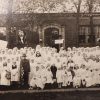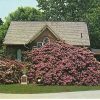Chestnut Hill Cemetery, with its entrance at 2613 Sackett Avenue in Cuyahoga Falls, just across the street from the entrance to Babb Run Park, is built on seven hills where native chestnut trees formerly grew. 200 years ago this land was a part of the Babb farm, which originally included hundreds of acres in what is now the west end of Cuyahoga Falls. The Babb Farm was at least locally famous in its day, for the variety of crops grown and the unusual large brick and stone house, still standing at the northeast corner of Sackett Avenue and Twenty-Sixth Street, which was the Babb homestead. It was built of locally quarried stone and brick burned on the farm, with framing and floors of native lumber from the Babb land.

The house is unusual in construction, with stone lintels, jambs and sill so accurately cut that no mortar had to be used in the joints. The brick walls of the upper two floors of the main house are three courses thick, with a four-inch air space between the two inner courses, anticipating a type of insulated wall construction usually thought to be quite modern of that time. Another unusual thing about the house is the spring, rising in the bedrock under the basement floor, which flows through a well that was used for the cold food storage. The household water supply was pumped from the well to the kitchen on the next floor and a bathroom on the floor above that. From the spring-fed well, water flowed by gravity to a stone curbed pool south of the house, which is said to have been a trout pool. From this pool water was piped to a steel watering tank or trough, for many years a landmark, which stood in a fence on the north side of Sackett Road, so that it could be used both by passing teams and stock in the yard of a tremendous barn that stood about forty yards west of the house. This is the round metal tank, now used for growing flowers, that stands near the curb on the Broad Boulevard side of the Cuyahoga Falls Library. When used as a watering trough, the overflow went through a stone culvert under Sackett Road into the head of the Babb Run gully where it joined with the other springs to form Babb Run, which flows south to the Cuyahoga River.

Some years ago a new water line was built to carry spring water direct from its source in the rock on the east side of 26th Street near Falls Avenue to the pond just west of the cemetery entrance. The constant supply of spring water is about 50 degrees which keeps the pond from freezing completely even in the coldest weather so there is some open water for the ducks at all times. Usually, there are a dozen or more species of wild ducks on the pond, some native and some introduced exotics, with other natives that drop in on migrations, sometimes staying all winter.
Just east of the cemetery entrance, is a large “early American” stone and weathered-siding house, with a garage to match, built for cemetery personnel. The cemetery office, just inside the cemetery entrance, was the first of the stone and weathered wood buildings in the neighborhood built in 1928 by Jack Downey with help from Andrew Schmitt and H.P. McAniff.
The construction was started in 1926. The first burial was in September of 1928.



I have a few questions about Babb farm! My great grandmother was a Zeller ( the Zeller Barn) passed Chestnut Cemetery which we were always told was part of the Zeller farm. The farm house was just down from the entrance to the now cemetery. My grandfather’s great grandfather was John Adam Zeller (wife was Elizabeth Hoover Zeller). I hope you get my message!